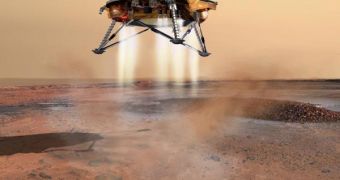Phoenix's nine month journey to the Red Planet is set to end tomorrow, May 25, with its landing in the north polar regions of Mars. Whether or not it manages to land remains uncertain until the spacecraft is safely on the ground, especially considering the relatively long list of failed missions to the Red Planet in the last two decades or so. Some say landing on Mars is hard, others however reckon that the spacecrafts were victims of NASA's bad managerial skills.
One of the latest and best examples is the Mars Polar Lander, which in 1999 was supposed to land in Mars' south polar region. It was carrying roughly the same experiments as the Phoenix Mars Lander, but soon after entry into the atmosphere contact with the spacecraft was lost. It is still accounted as missing. As it turns out, the engines that were supposed to decelerate its entry into the atmosphere and land it on the surface hadn't even been tested, in order to save funds.
Phoenix will land in an area of the planet averaging temperatures of -90 degrees Celsius. Observations from the orbit reveal that the respective area presents ice just below the surface. If this is true, then Phoenix will be able to investigate it and reveal unique details about the past climate of the Red Planet, such as whether it was ever suitable for life or if it periodically changes tilt, to allow the ice below its surface to melt and moisture the soil every once in a while.
"Our goal is to look for a habitable zone. Whether or not anything lives there will be for someone else to determine", says principal investigator Peter Smith of the University of Arizona.
Unlike the previous three missions to the Red Planet, when the aircrafts - Spirit, Opportunity and Pathfinder - landed safely with the help of protective airbags, the Phoenix Mars Lander relies on a parachute and a series of thrusters to touchdown on the surface, preferably at speeds lower than 10 kilometers per hour. The method was successful in the case of the Viking missions, but the 'faster, better, cheaper' policy applied by NASA in the 1990s seems to have gone wrong in the case of the Mars Polar Lander.
In fact, this is the first time since 1976 when NASA would safely land a spacecraft using this method. The most likely reason for the failure of the Mars Polar Lander seems to have been a software glitch that shut down the engines of the spacecraft too soon, thus crashing it into the surface. This will not be the case of the Phoenix lander, since its software was greatly improved.
And if system failure is not a problem, then there's always the chance of falling victim to boulders. Only one badly placed boulder would be just enough to terminate a sustained effort lasting several years. Alternatively, Phoenix could land on a steep slope, only to disable its sunlight gathering capabilities. This is why when NASA engineers chose the landing spot, sites as flat and as boulder free as possible were a priority. Ever since it arrived on Mars' orbit, the Mars Reconnaissance Orbiter has been searching franticly for a favorable landing site.
The designated landing spot is an area about 80 by 20 kilometers across, but even with a camera able to view objects as small as a dinner plate, some hazards are inevitable. As Murphy's Law says: 'if something can go wrong, then it will'. Frankly, Phoenix's landing depends mostly on luck and can be decided in the last seconds of the landing sequence, as the spacecraft draws near to the final steps of its journey.

 14 DAY TRIAL //
14 DAY TRIAL //